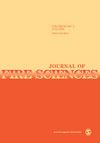火灾环境中简易屏蔽热电偶的研制与验证
IF 1.9
4区 工程技术
Q2 ENGINEERING, MULTIDISCIPLINARY
引用次数: 0
摘要
提出了一种新型的简单屏蔽热电偶,该热电偶能够在火灾环境中进行辐射校正,并且比传统的吸气式热电偶具有更简单的结构和更大的便利性。然后在模拟火灾环境中比较了裸珠、双屏蔽吸气和简单屏蔽热电偶的测量误差。此外,还使用木垛进行了火灾实验,以验证所提出的简单屏蔽热电偶在使用三分之一比例ISO 9705房间的真实火灾环境中的测量性能。简单的屏蔽热电偶产生了相当准确的温度,在模拟火灾环境中,温度降至实际气体温度的5%以内。此外,在实际火灾环境中,简单屏蔽热电偶的表面发射率和安装角度的变化进一步降低了测量误差。辐射热通量为20 kW/m2,证实裸珠热电偶与吸气式热电偶相比具有高达80%的相对测量误差,而所提出的简单屏蔽热电偶与吸气热电偶相比能够在约15%的相对误差内测量温度。本文章由计算机程序翻译,如有差异,请以英文原文为准。
Development and validation of simple-shield thermocouple in fire environments
A novel simple-shield thermocouple that is capable of radiation correction in fire environments and that has a simpler structure and greater convenience than conventional aspirated thermocouples was proposed. The measurement errors of bare-bead, double-shield aspirated, and simple-shield thermocouples were then compared in a simulated fire environment. In addition, a fire experiment using wood cribs was performed in order to verify the measurement performance of the proposed simple-shield thermocouple in a real fire environment using a one-third-scale ISO 9705 room. The simple-shield thermocouple produced fairly accurate temperatures that fell within 5% of the actual gas temperature in the simulated fire environment. In addition, variations in the surface emissivity and the installation angle of the simple-shield thermocouple in the real fire environment further reduced the measurement error. With a radiant heat flux of 20 kW/m2, it was confirmed that the bare-bead thermocouple had a relative measurement error of up to 80% compared to the aspirated thermocouple, while the proposed simple-shield thermocouple was capable of measuring the temperature within a relative error of around 15% compared to the aspirated thermocouple.
求助全文
通过发布文献求助,成功后即可免费获取论文全文。
去求助
来源期刊

Journal of Fire Sciences
工程技术-材料科学:综合
CiteScore
4.00
自引率
0.00%
发文量
14
审稿时长
2.5 months
期刊介绍:
The Journal of Fire Sciences is a leading journal for the reporting of significant fundamental and applied research that brings understanding of fire chemistry and fire physics to fire safety. Its content is aimed toward the prevention and mitigation of the adverse effects of fires involving combustible materials, as well as development of new tools to better address fire safety needs. The Journal of Fire Sciences covers experimental or theoretical studies of fire initiation and growth, flame retardant chemistry, fire physics relative to material behavior, fire containment, fire threat to people and the environment and fire safety engineering. This journal is a member of the Committee on Publication Ethics (COPE).
 求助内容:
求助内容: 应助结果提醒方式:
应助结果提醒方式:


